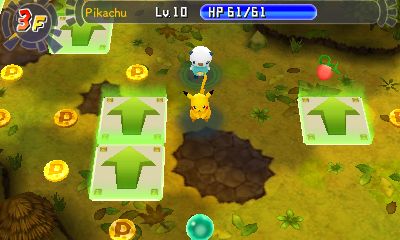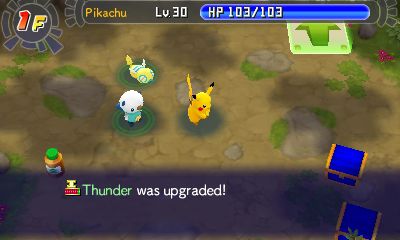Even the most cynical, Nintendo-hating amongst the gaming community would have to hold up their hands and concede: even though we are a mere five months deep, 2013 has been a blinder thus far for the 3DS. First party heroes like the ghost-chasing Luigi’s Mansion 2 and the superior cast of Fire Emblem have already kept us glued to the wee three-dimensional beastie, and there is much more to look forward to courtesy of Tom Nook, Link, Donkey Kong and the return of Mario and Luigi. With a proper canonical Pokémon RPG sequel on the cards this October, we now have the opportunity to revisit the Mystery Dungeon series, as Chunsoft attempt to surf the wave of 3DS popularity with their first game since last year’s truly special Virtue’s Last Reward.
Gates to Infinity is the latest in a series that combines Chunsoft’s dungeon-crawling, Rogue-influenced mainstay with the role playing, monster-collecting Pokémon universe – this time basing things primarily around the Unova region which featured in the excellent Black & White titles. The story is your usual chatty, whimsical nonsense in which you take the role of a human who has been transformed into a Pokémon, and are whisked away into a plot that involves lots of happy-clappy do-gooding issues like conservation, and learning important lessons about life and stuff. That and kicking the arses of all kinds of Poké-beasts left, right and centre.
 From the get-go you are able to select from a cast of five existing critters, and rename them if you wish. The selection is great, as each of the base set of characters is distinctly different. Of course, one of this quintet is everyone’s favourite aggressive, squirrel-like vermin, Pikachu – but you can also mix it up with sea-otter, Oshawott, splendid “fire pig”, Tepig, spiteful-looking grass snake, Snivy, or the undeniably cute dinosaur dude, Axew. As gameplay progresses, you build a team of these little guys and are able to swap and change your party depending on your particular needs. Even if you are not a fan of the source material, you can probably figure out that all Pocket Monsters have their own special characteristics and elemental affiliations. Pikachu likes to use electricity based attacks, for example, whereas Tepig is a dab hand at arson.
From the get-go you are able to select from a cast of five existing critters, and rename them if you wish. The selection is great, as each of the base set of characters is distinctly different. Of course, one of this quintet is everyone’s favourite aggressive, squirrel-like vermin, Pikachu – but you can also mix it up with sea-otter, Oshawott, splendid “fire pig”, Tepig, spiteful-looking grass snake, Snivy, or the undeniably cute dinosaur dude, Axew. As gameplay progresses, you build a team of these little guys and are able to swap and change your party depending on your particular needs. Even if you are not a fan of the source material, you can probably figure out that all Pocket Monsters have their own special characteristics and elemental affiliations. Pikachu likes to use electricity based attacks, for example, whereas Tepig is a dab hand at arson.
Rather than going down the standard Pokémon training, collecting, levelling-up role-playing route of the traditional Game Freak instalments, a Mystery Dungeon title involves entering randomly generated dungeon areas where you use your party of monsters to reach the exit, fighting off hostile wild Pokémon along the way, levelling up and learning new moves. Although you have a party of four, you only get to take control of your main character, with the actions of the other three dependent of pre-programmed command options. I found that this did not always pan out to my liking, with my companions directly disobeying their orders on occasions, which was a tad annoying to say the least.
 Combat is turn-based but in real time, with each of the four face buttons allocated an attack type. Using these special moves drains your “PP”, so care has to be taken how you approach combat to maximise your stocks. Unlike previous Pokémon Mystery Dungeon titles, your party do not have “hunger” to worry about, and any levelling-up is carried over into the next area. It may seem a bit harsh to criticise the dungeon layouts themselves, since they are randomly generated, but on more than one occasion I found that my Smithachu had spawned in a dungeon in which the exit was in plain sight of the starting point.
Combat is turn-based but in real time, with each of the four face buttons allocated an attack type. Using these special moves drains your “PP”, so care has to be taken how you approach combat to maximise your stocks. Unlike previous Pokémon Mystery Dungeon titles, your party do not have “hunger” to worry about, and any levelling-up is carried over into the next area. It may seem a bit harsh to criticise the dungeon layouts themselves, since they are randomly generated, but on more than one occasion I found that my Smithachu had spawned in a dungeon in which the exit was in plain sight of the starting point.
Dungeon crawls are broken up by lengthy passages of banal, sadly unskippable text that would appeal to only the most masochistic Poké-fan. I am able to tolerate the jolly, irrepressibly upbeat music and “Always believe in your dreams!” banter to a degree, but this is just a bit much for even my brain to deal with. There is some over-world exploring to do, and simple puzzles to solve, but these are hardly tricky to work out and usually involve something straightforward like knocking down a log to create a makeshift bridge. There is the opportunity to use the spoils of your exploits to build shops and play mini-games in the whimsically-named Pokémon Paradise, and you will also find notice boards in the town area which allow you to take on side quests, ranging from simple item fetching to a good old bounty hunt.
 Being a 3DS game, there are a few gimmicky extras that employ the unique capabilities of the console. The game looks blooming marvellous, for a start. Big, bright, extremely colourful and with some really nice 3D models of all your favourite monsters, it really pops and is one of the most visually arresting Pokémon games in recent memory. “Discover a Magnagate” allows you to use the 3DS camera to search your environs for any circular objects, which if snapped correctly in an adequately-lit area will create an AR portal that can be explored as a side mission, usually with some tasty items to be found that can be used in the main game. Multiplayer options allow you to go dungeoneering with friends should you wish, and there is the promise of downloadable dungeons, with Nintendo following the successful implementation of DLC in Fire Emblem.
Being a 3DS game, there are a few gimmicky extras that employ the unique capabilities of the console. The game looks blooming marvellous, for a start. Big, bright, extremely colourful and with some really nice 3D models of all your favourite monsters, it really pops and is one of the most visually arresting Pokémon games in recent memory. “Discover a Magnagate” allows you to use the 3DS camera to search your environs for any circular objects, which if snapped correctly in an adequately-lit area will create an AR portal that can be explored as a side mission, usually with some tasty items to be found that can be used in the main game. Multiplayer options allow you to go dungeoneering with friends should you wish, and there is the promise of downloadable dungeons, with Nintendo following the successful implementation of DLC in Fire Emblem.
VERDICT: With generous checkpoints, lots of side-missions, and the feel-good factor that comes with all Pokémon games, played in short bursts this is not an unpleasant experience. The crushing reality is that anything new or a bit whizzy that Gates to Infinity tries to do ultimately boils down to the same dull-as-dishwater trawls through unimaginative dungeon areas. It is an overly simplistic affair for those used to the tough Rogue-like experiences of the past, and as such your money is probably best spent elsewhere, or saved until the release of the inevitably excellent X & Y later this year.

AVERAGE. The epitome of a 50/50 game, this title will be unspectacular but inoffensive, charmless but amiable. We aren’t condemning a game by scoring it a 5, but we certainly aren’t championing it, either.





